A Day to (pokeberry) dye
In late September, 2020, it was finally time to dye my wool and Kelly’s thread with the pokeberries. After gathering pokeberries for two months, we had collected over 2.5 kg (over 5 lbs) of berries. We took our stored berries out of our freezers the night before to thaw them.
Preparing the pokeberries
It was both during the pandemic and messy, so we worked outside in the yard and on the deck. We sat in the yard with our bags of thawed berries. For those berries still on their stalks, we stripped them from the stems. Others were already stripped, and some already squished (thanks Lilah!).
I never wanted to dye my phone/camera purple when I had the purple hands, so I don’t have photo evidence from gathering. Here we are in the yard with our red-purple hands.
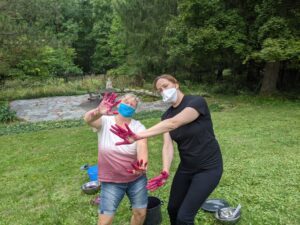 Kelly and me in the yard. Our hands are red-purple from prepping the pokeberry stalks for the dye vat.
Kelly and me in the yard. Our hands are red-purple from prepping the pokeberry stalks for the dye vat.We cooked the berries in water and vinegar outside on the grill. The pokeberry dye instructions in Rebecca Burgess’ book calls for cooking the berries for ninety minutes to extract the color. It cautioned not to boil the berries as that may alter the color.
The searing burner on our gas grill is really only meant to go hot, so I had to keep on turning the burner off and on and adjusting the pot’s lid on and off to keep the mixture in the range of the 160-180 degrees Fahrenheit.
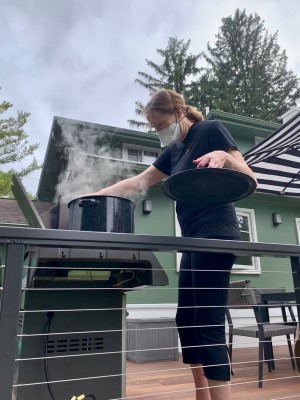 This is me stirring the berries, the candy thermometer I used to check the temperature is not visible but in my right hand.
This is me stirring the berries, the candy thermometer I used to check the temperature is not visible but in my right hand.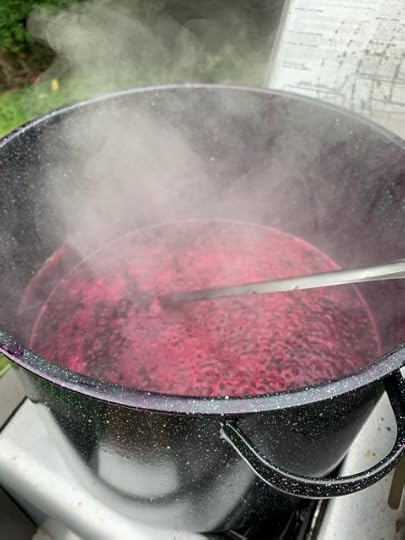 The pokeberries “cooking” in the dye pot.Pokeberry dye making.
The pokeberries “cooking” in the dye pot.Pokeberry dye making.After ninety minutes, we strained out the pulp and seeds, leaving an almost-opaque purple liquid.
How we used the pokeberry dye
For this first dye project, I planned to re-dye a made object rather than unknitted yarn or unspun roving. I had knitted a pair of socks in 2013 (the socks on Ravelry) that I wanted to re-dye. They were holding up well with use and fit nicely, except the bright “purple Viking” color was fading. When I hand-washed them, the blue part especially was bleeding out in the soak. My lovely fuschia socks were turning a muddy rose color.
You can see that the socks in the pre-wetting pot in 2020 are less bright than in the photo in 2013. I did hear from a yarn-store owner that I could use vinegar to help the color hold (for example, here’s an article from Purl Soho on re-fixing dye). The treatment seemed to slow the loss of color but, of course, it didn’t restore the color that had been lost.
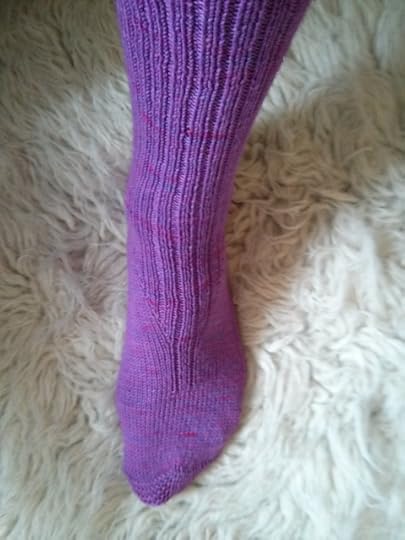 2013: I proudly model my just finished “purple Viking” socks.
2013: I proudly model my just finished “purple Viking” socks.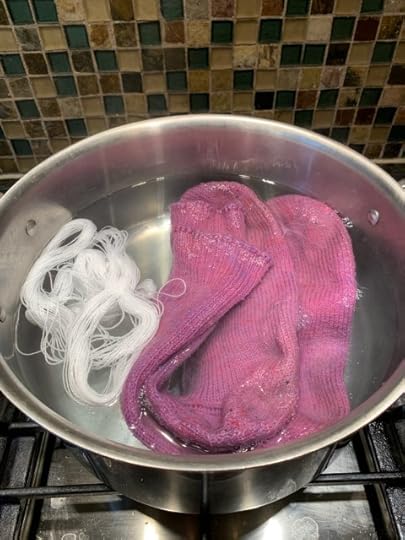 2020: undyed thread and my socks in vinegar and water, warming on the stove before the dye. Notice the socks are still pink, but less than in 2013. Wool socks: before in 2013 and 2020.
2020: undyed thread and my socks in vinegar and water, warming on the stove before the dye. Notice the socks are still pink, but less than in 2013. Wool socks: before in 2013 and 2020. Kelly brought some thread to dye for a stitching project.
The instructions in Harvesting Color: How to Find Plants and Make Natural Dyes called for pre-wetting the fiber in a warm solution of water and vinegar. We did that indoors on the stove.
Finally pokeberry dyeing!
After two months of gathering berries and some time pre-wetting the fiber and extracting the color from the berries, it was time to dye. We put the socks, the embroidery floss into the pokeberry liquid and watched them turn a deep fuschia color.
We heated our items in the dye pot for another 90 minutes, again turning the burner off and on to maintain the right temperature window. After 90 minutes, I took the whole pot off of the burner and put it on the patio to let it steep overnight.
In the morning, I pulled the items out of the dye vat to let them drain. Then, I rinsed them. The items let a lot of dye out. The socks remained a beautiful rich deep color but Kelly’s thread gave up most of the purple and stayed only a little dingy pink. We were so disappointed!
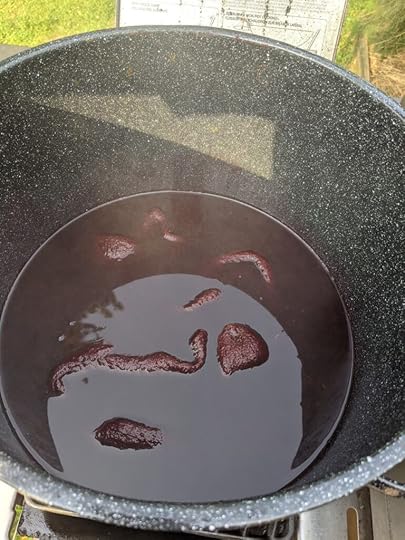 The wool and thread in the dye
The wool and thread in the dye 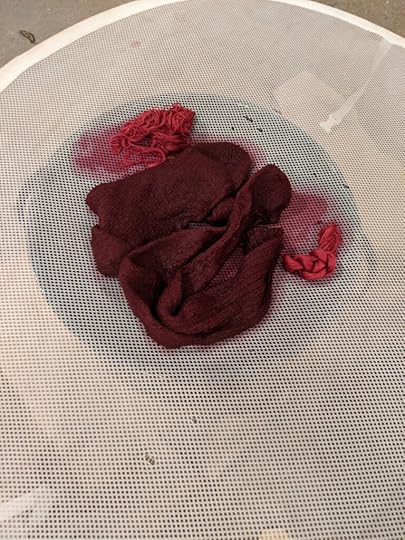 The dyed items draining after soaking overnight.
The dyed items draining after soaking overnight.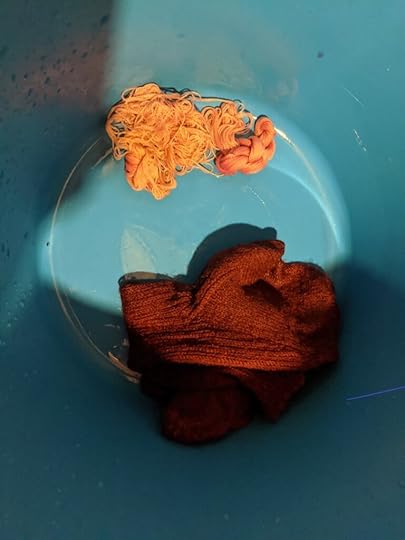 After draining and being rinsed, the socks stayed dark, the thread lost most of its color.The items after soaking in the dye vat: before and after rinsing.
After draining and being rinsed, the socks stayed dark, the thread lost most of its color.The items after soaking in the dye vat: before and after rinsing.Still, it was an experiment and the socks are beautiful. Plus we had a day in the warm sunshine experimenting with old tech (fire and plant dyes) and new things for us.
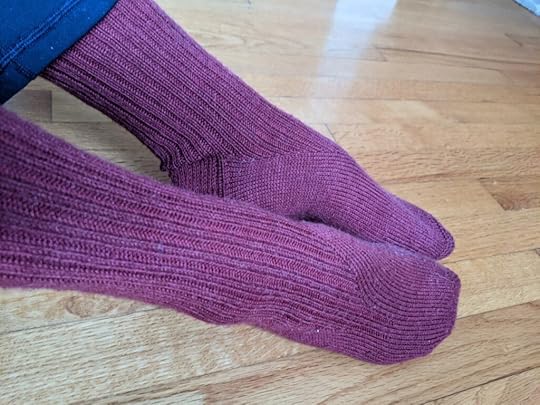 The socks in January 2020 after re-dyeing them with pokeberries
The socks in January 2020 after re-dyeing them with pokeberries
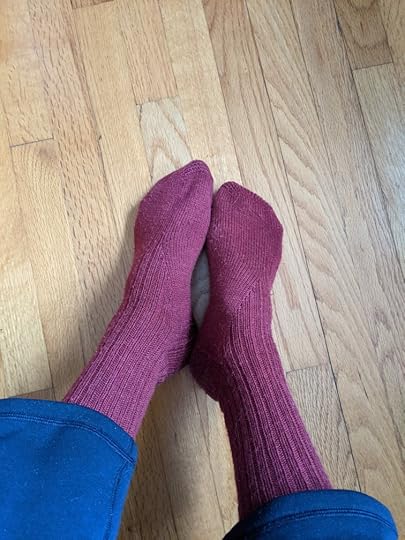 The socks after dyeingThe blue color I missed is back, different, but back. And I love the rich color of pokeberry dyed socks
The socks after dyeingThe blue color I missed is back, different, but back. And I love the rich color of pokeberry dyed socks Dye another day
The main change I’d make to this setup was how to heat the dye pot. On the grill burner, the pot’s temperature was all over the place. The off/on dance I had to do with the burner and the pot lid was pretty fussy and I’m sure error prone. I’m glad the dye didn’t suffer too much.
Ultimately, that burner is poorly suited to keeping things below a simmer. Next time I will try a slow cooker, something designed to be on a lower temperature for a long time.
Overall, this was a wonderful afternoon of dyeing after a lot of fun gathering. Now I’m eyeing Sumac berries on my walk.
The post A Day to (pokeberry) dye appeared first on Scientific Ink.




